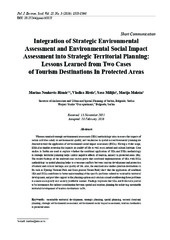Приказ основних података о документу
Integration of strategic environmental assessment and environmental social impact assessment into strategic territorial planning: Lessons learned from two cases of tourism destinations in protected areas
| dc.creator | Nenković-Riznić, Marina | |
| dc.creator | Ristić, Vladica | |
| dc.creator | Milijić, Saša | |
| dc.creator | Maksin, Marija | |
| dc.date.accessioned | 2018-12-26T10:59:53Z | |
| dc.date.available | 2018-12-26T10:59:53Z | |
| dc.date.issued | 2016 | |
| dc.identifier.issn | 1230-1485 | |
| dc.identifier.uri | https://raumplan.iaus.ac.rs/handle/123456789/273 | |
| dc.description.abstract | Whereas standard strategic environmental assessment (SEA) methodology aims to assess the impacts of certain activities solely on environmental quality, new tendencies in spatial and environmental planning are directed toward the application of environmental social impact assessment (ESIA). Having a wider scope, ESIA also implies assessing the impacts on quality of life as well as on natural and cultural heritage. Case studies in Serbia are used to explore whether the combined application of SEA and ESIA methodology in strategic territorial planning helps control negative effects of tourism, namely in protected areas (PA). The results/findings of the analysed case studies prove that combined implementation of SEA with ESIA methodology in spatial planning helps to overcome conflicts between tourism development and protection of natural and cultural heritage, and quality of life. Also, the analysed case studies (tourism destinations in PA such as Djerdap National Park and Stara planina Nature Park) show that the application of combined SEA and ESIA contributes to better understanding of the specific problems related to sustainable territorial development, and provides support to the planning options and solutions aimed at addressing these problems in a more ecologically and socially justifiable manner. Findings implicate that SEA and ESIA have proved to be instruments for indirect coordination between spatial and tourism planning for achieving sustainable territorial development of tourism destinations in PA. | en |
| dc.publisher | Hard, Olsztyn 5 | |
| dc.relation | info:eu-repo/grantAgreement/MESTD/Technological Development (TD or TR)/36036/RS// | |
| dc.relation | info:eu-repo/grantAgreement/MESTD/Integrated and Interdisciplinary Research (IIR or III)/47014/RS// | |
| dc.rights | openAccess | |
| dc.source | Polish Journal of Environmental Studies | |
| dc.subject | sustainable territorial development | en |
| dc.subject | strategic planning | en |
| dc.subject | spatial planning | en |
| dc.subject | sectoral (tourism) planning | en |
| dc.subject | strategic environmental assessment | en |
| dc.subject | environmental social impact assessment | en |
| dc.subject | tourism destina | en |
| dc.title | Integration of strategic environmental assessment and environmental social impact assessment into strategic territorial planning: Lessons learned from two cases of tourism destinations in protected areas | en |
| dc.type | article | |
| dc.rights.license | ARR | |
| dcterms.abstract | Ристић, Владица; Ненковић-Ризнић, Марина; Милијић, Саша; Максин, Марија; | |
| dc.citation.volume | 25 | |
| dc.citation.issue | 3 | |
| dc.citation.spage | 1353 | |
| dc.citation.epage | 1366 | |
| dc.citation.other | 25(3): 1353-1366 | |
| dc.citation.rank | M23 | |
| dc.identifier.wos | 000377240700047 | |
| dc.identifier.doi | 10.15244/pjoes/61851 | |
| dc.identifier.scopus | 2-s2.0-85027120886 | |
| dc.identifier.fulltext | https://raumplan.iaus.ac.rs//bitstream/id/1615/270.pdf | |
| dc.type.version | publishedVersion |

